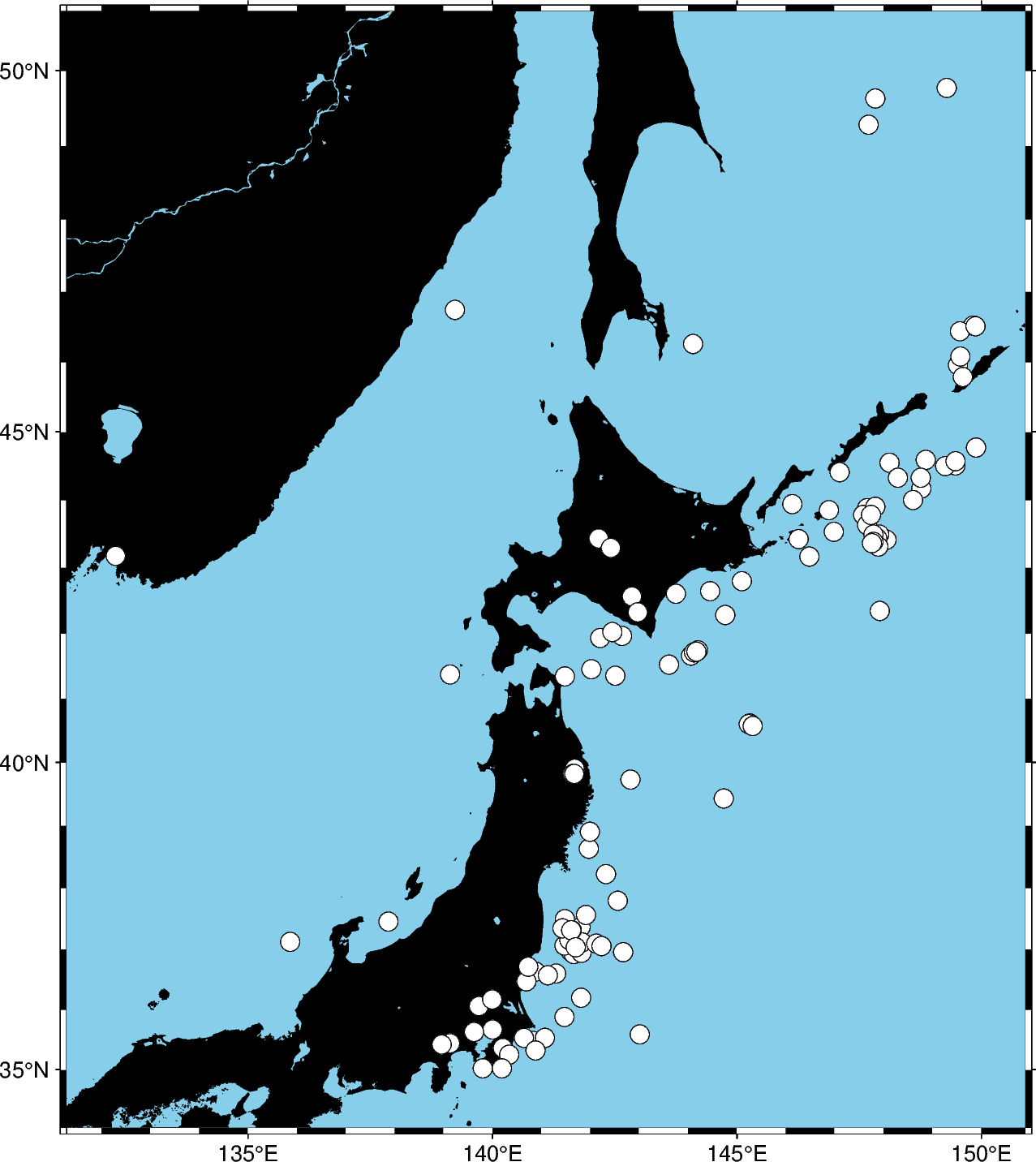Note
Click here to download the full example code
Plotting data points
GMT shines when it comes to plotting data on a map. We can use some sample data
that is packaged with GMT to try this out. PyGMT provides access to these
datasets through the pygmt.datasets package. If you don’t have the data
files already, they are automatically downloaded and saved to a cache directory
the first time you use them (usually ~/.gmt/cache).
import pygmt
For example, let’s load the sample dataset of tsunami generating earthquakes
around Japan using pygmt.datasets.load_sample_data.
The data is loaded as a pandas.DataFrame.
data = pygmt.datasets.load_sample_data(name="japan_quakes")
# Set the region for the plot to be slightly larger than the data bounds.
region = [
data.longitude.min() - 1,
data.longitude.max() + 1,
data.latitude.min() - 1,
data.latitude.max() + 1,
]
print(region)
print(data.head())
Out:
[131.29, 150.89, 34.02, 50.77]
year month day latitude longitude depth_km magnitude
0 1987 1 4 49.77 149.29 489 4.1
1 1987 1 9 39.90 141.68 67 6.8
2 1987 1 9 39.82 141.64 84 4.0
3 1987 1 14 42.56 142.85 102 6.5
4 1987 1 16 42.79 145.10 54 5.1
We’ll use the pygmt.Figure.plot method to plot circles on the
earthquake epicenters.
fig = pygmt.Figure()
fig.basemap(region=region, projection="M15c", frame=True)
fig.coast(land="black", water="skyblue")
fig.plot(x=data.longitude, y=data.latitude, style="c0.3c", color="white", pen="black")
fig.show()

Out:
<IPython.core.display.Image object>
We used the style c0.3c which means “circles of 0.3 centimeter size”. The
pen parameter controls the outline of the symbols and the color
parameter controls the fill.
We can map the size of the circles to the earthquake magnitude by passing an
array to the size parameter. Because the magnitude is on a logarithmic
scale, it helps to show the differences by scaling the values using a power
law.
fig = pygmt.Figure()
fig.basemap(region=region, projection="M15c", frame=True)
fig.coast(land="black", water="skyblue")
fig.plot(
x=data.longitude,
y=data.latitude,
size=0.02 * (2**data.magnitude),
style="cc",
color="white",
pen="black",
)
fig.show()

Out:
<IPython.core.display.Image object>
Notice that we didn’t include the size in the style parameter this time,
just the symbol c (circles) and the unit c (centimeter). So in this
case, the size will be interpreted as being in centimeters.
We can also map the colors of the markers to the depths by passing an array
to the color parameter and providing a colormap name (cmap). We can
even use the new matplotlib colormap “viridis”. Here, we first create a
continuous colormap ranging from the minimum depth to the maximum depth of
the earthquakes using pygmt.makecpt, then set cmap=True in
pygmt.Figure.plot to use the colormap. At the end of the plot, we
also plot a colorbar showing the colormap used in the plot.
fig = pygmt.Figure()
fig.basemap(region=region, projection="M15c", frame=True)
fig.coast(land="black", water="skyblue")
pygmt.makecpt(cmap="viridis", series=[data.depth_km.min(), data.depth_km.max()])
fig.plot(
x=data.longitude,
y=data.latitude,
size=0.02 * 2**data.magnitude,
color=data.depth_km,
cmap=True,
style="cc",
pen="black",
)
fig.colorbar(frame='af+l"Depth (km)"')
fig.show()

Out:
<IPython.core.display.Image object>
Total running time of the script: ( 0 minutes 5.040 seconds)